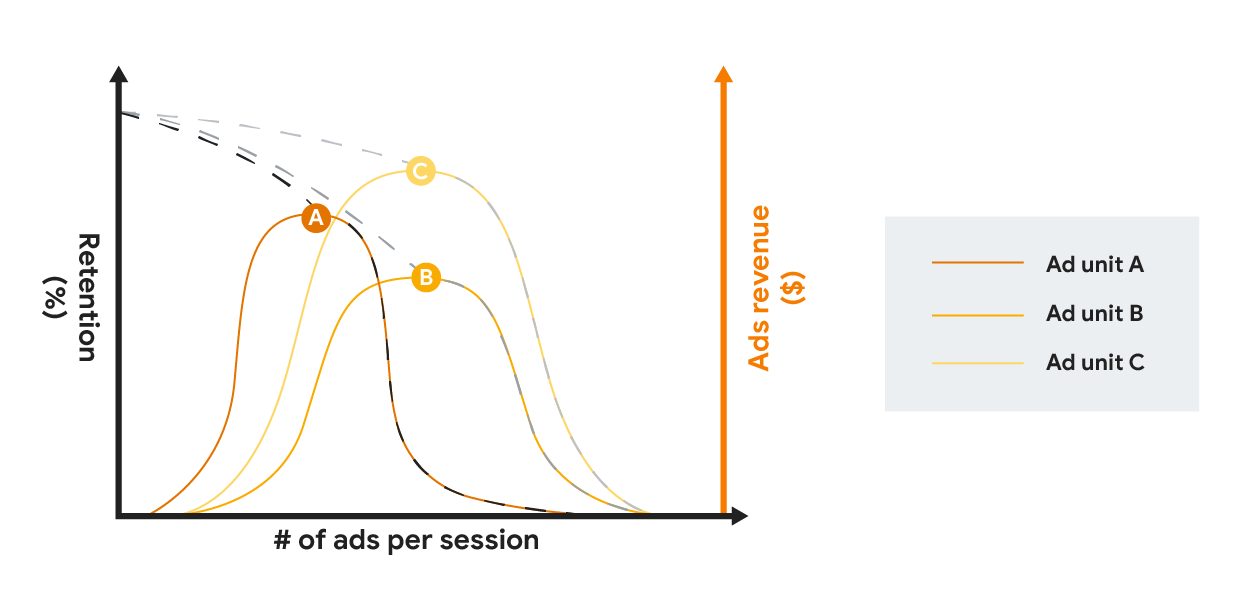솔루션 개요
광고 형식 채택 테스트란 무엇인가요?
앱이 하이브리드 수익형이거나 광고 수익으로 구동되는지 여부에 관계없이 여러 다른 광고 형식의 채택은 복잡한 문제일 수 있습니다.
모든 광고 형식이 모든 앱에 적합하진 않으며 앱 속성에 따라 일부 광고 형식이 성능이 더 뛰어날 수 있습니다. 새 광고 형식을 구현할 때는 사용자 환경 또는 유지율에 대해 부정적인 영향을 걱정할 수 있지만 새 광고 형식을 적절하게 계측할 경우 수익 및 유지율을 늘릴 수 있을지에 대해 궁금해 하실 수도 있습니다.

이러한 미지의 문제를 해결하기 위해 Firebase에서는 새로운 광고 형식 채택을 테스트하고 이에 대해 데이터 중심의 의사결정을 내릴 수 있게 도와주는 도구들이 제공됩니다.
Firebase를 사용하면 소규모 사용자 하위 집합을 대상으로 새 광고 형식의 성능에 대해 A/B 테스트를 수행할 수 있습니다.
테스트 결과를 관찰하고 새 광고 형식이 기존 광고 형식보다 성능이 더 뛰어난지에 대한 Firebase의 권장사항을 검토할 수 있습니다.
변화에 따른 긍정적인 영향을 확신할 수 있으면 버튼 하나만 클릭하여 더 많은 사용자들에게 변경사항을 적용할 수 있습니다.
비즈니스 사례와 가치
새 광고 형식 추가를 위해 Google AdMob 및 Firebase 도구를 사용하는 개발자 및 게시자는 유지율을 안정적으로 유지하면서도 최대 10배*까지 수익 증가 효과를 얻고 있습니다.
*2020년 8개 대형 게시자의 결과를 기반으로 한 수익 증가

|
Pomelo Games는 Firebase를 사용하여 플레이어를 잃지 않고 수익을 최대 35%까지 늘릴 수 있었습니다. |

|
Qtonz는 Firebase를 사용해서 광고 수익을 4배 늘리고 ARPDAU를 190% 늘릴 수 있었습니다. |
솔루션 구현
이 솔루션을 구현하려면 단계별 튜토리얼을 따라할 수 있습니다(이 페이지 뒷 부분에서 이 튜토리얼의 개요 참조).
이 다단계 튜토리얼에서는 Firebase를 사용하여 앱에 새 Google AdMob 광고 형식을 테스트하는 방법을 알아봅니다. 여기에서는 보상형 전면 광고가 예시 테스트 사례로 사용되지만, 이를 기반으로 해서 동일한 단계를 사용하여 다른 광고 형식을 테스트할 수 있습니다.
이 튜토리얼에서는 앱에서 이미 AdMob를 사용 중이고 다른 광고 단위 (새로운 광고 형식 포함)를 추가하여 앱 수익 또는 기타 측정항목에 미치는 영향을 테스트한다고 가정합니다. 하지만 앱에서 아직 AdMob를 사용하지 않더라도 문제가 없습니다. 또한 이 튜토리얼의 단계를 통해 앱에 광고 단위 추가가 앱의 측정항목에 영향을 주는지 확인할 수 있습니다.
이 솔루션에 사용된 제품 및 기능
|
Google AdMob Google AdMob을 사용하면 앱 내에서 게재되는 광고 단위 대안을 만들 수 있습니다. AdMob를 Firebase에 연결하면 AdMob이 광고 전략 최적화를 개선하기 위해 광고 수익 정보를 Firebase로 전송합니다. Google Analytics Google Analytics는 사용자 참여 및 유지율과 총 수익, AdMob 수익, 구매 수익 등의 수익 창출 측정항목에 대한 유용한 정보를 제공합니다. 또한 사용자 잠재고객 및 세그먼트를 만들 수 있게 해줍니다. |
Firebase Remote Config Firebase Remote Config를 사용하면 새 버전의 앱을 게시하지 않고도 원하는 사용자 세그먼트에 맞게 앱의 동작과 모양을 동적으로 변경하고 맞춤설정할 수 있습니다. 이 튜토리얼에서는 Remote Config 매개변수를 사용하여 사용자에게 새 광고 단위를 표시할지 여부를 제어합니다. Firebase A/B Testing Firebase A/B Testing는 앱에서 제품 및 마케팅 실험을 실행하기 위한 인터페이스와 인프라를 제공합니다. 실험 대안을 사용자에게 배포한 후 통계 분석을 실행하여 수익 또는 사용자 유지율과 같은 선택한 주요 측정항목을 기준으로 실험 대안이 통제 그룹보다 실적이 우수한지 확인합니다. |

솔루션 튜토리얼 개요
AdMob를 사용하여 테스트할 새 광고 단위 대안 만들기
AdMob에서 새 보상형 전면 광고 단위를 만듭니다.
앱 코드 내에서 광고 단위 게재위치를 구현합니다.
-
테스트 실행의 기준이 되는 테스팅 기본사항, 타겟팅, 목표를 정의합니다.
테스트 대안을 정의하고 테스트 사용자에게 새 광고 단위를 표시할지 여부를 제어하는 Remote Config 매개변수를 설정합니다.
앱 코드에서 Remote Config 매개변수 값 처리
앱에서 Remote Config 매개변수를 사용합니다.
매개변수 값을 기준으로 광고 단위를 표시하는 논리를 구현합니다.
Firebase Console에서 A/B 테스트 시작 및 테스트 결과 검토
테스트를 시작하고 며칠 또는 몇 주 동안 실행한 후 Firebase Console에서 A/B 테스트가 A/B 테스트의 기본 목표를 기준으로 우수한 대안을 갖는지 확인합니다.
각 대안에 대한 보조 측정항목의 영향을 검토해서 대안이 해당 측정항목에 대해 의도치 않은 부정적인 영향을 주지 않았는지 확인합니다.
-
A/B Testing에 따라 새 광고 형식을 표시하는 대안이 최적 대안으로 확인되었으면 실험 대상의 모든 사용자, 앱의 모든 사용자, 사용자 중 하위 집합에 대해 해당 광고 형식 표시를 시작할 수 있습니다.
최적 대안이 확실하게 확인되지 않은 경우에는 실험을 계속 실행하여 데이터를 더 수집하거나 결론을 내릴 수 없는 결과만 있고 실험이 이미 장기간 실행된 경우에는 실험을 종료할 수 있습니다.

